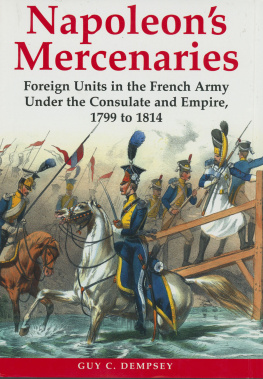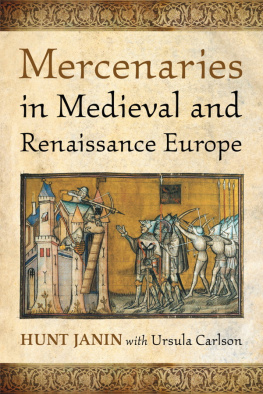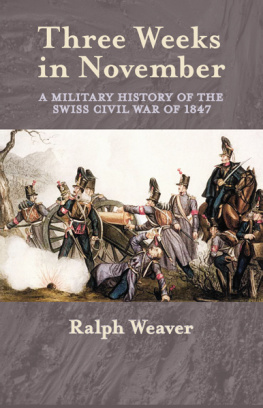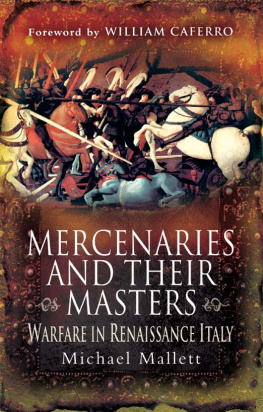ONE MILLION MERCENARIES
One Million Mercenaries
Swiss Soldiers in the Armies
of the World
by
John McCormack
LEO COOPER
LONDON
First published in Great Britain in 1993 by
LEO COOPER
190 Shaftesbury Avenue, London WC2H 8JL
an imprint of
Pen & Sword Books Ltd,
47 Church Street, Barnsley, South Yorkshire S70 2AS
Copyright John McCormack 1993
A CIP catalogue record for this book is available from the British Library.
ISBN 085052 312 5
Typeset by Yorkshire Web, Barnsley, S. Yorks
in Plantin 10 point
Printed by Redwood Books
Trowbridge, Wiltshire
FOR PHILIPPA
ACKNOWLEDGEMENTS
All the illustrations have been provided by the Muse des Suisses lEtranger at the Chteau de Penthes, Pregny-Chambesy, Geneva, whose assistance is gratefully acknowedged. The originals of illustrations 2, 3, 4 and 5 are in the Muse des Beaux Arts, Basle and of illustrations 8, 11, 12, 13, 14 and 25 in the Swiss National Museum, Zurich.
CONTENTS
The Most Powerful Army in Europe
Morgarten to Marignano 1315-1516 |
The Development of the Mercenary System
Bicocca to Arques 1521-1590 |
The Heyday of the Mercenary Business
Ivry to Neerwinden 1590-1693 |
The Decline of the Mercenary Business
Blenhein to Savannah 1704-1779 |
Last Throes of Mercenary Service
The Bastille to the Vatican 1789-today |
We are well aware that God and nature have set you such skill and strength that you yourselves are in a position to defend yourselves against powerful enemies.
Oliver Cromwell Writings III. 159.
The modern mercenary suddenly arrived on the worlds television screens in the Congo in 1960. Against the background of an African State experiencing a difficult transition from colonialism and riven by civil war appeared the disturbing but fascinating pictures of white guns for hire, described by the media as mercenaries. Who were these paid killers, and what exactly was a mercenary?
During the five years of the Congo troubles, from the Katanga secession in July, 1960, to the end of the Simba War in October, 1965, there were at any one time only about 2300 mercenaries in the Congo, possibly rising to 500 on occasion. Their impact on public opinion, however, far outweighed their small numbers. The brutalities of war, spotlighted by the television camera for the first time instead of hidden away on some distant battlefield, and the racist overtones of white professional soldiers slaughtering black Africans, created a sinister and troubling image for these new soldiers of fortune.
Most of the mercenary officers were ex-officers or NCOs of the various European armies Hoare, who fought with the Chindits in Burma, Peters and Wicks were all ex-British army; Denard ex-French marines; Faulques ex-French Foreign Legion; Moeller ex-German army. The Belgian, Schramme was the principal exception, having been drawn into the war through his position as a planter in Katanga. Although some of the rank and file came from similar backgrounds, the majority were young South Africans and Rhodesians without previous military experience.
A UN Official, Dr Mekki Abbas, found that the motives for the mercenaries enlistment ranged from the desire for financial gain, lust for adventure or domestic troubles to the wish to serve for a good cause. For young Afrikaaners enlistment was not too serious a step the enlistment period was only six months, there was just enough danger to be glamorous without too high a chance of being killed, and if the going got too tough the border was nearby. As will be seen, this mixture of half-understood motivations were the same as those that had driven one million of their Swiss predecessors to join up during the previous five hundred years.
The mercenary phenomenon reappeared at this time because of the special nature of the conflict in the Congo. Guerrilla warfare without major engagements and the absence of a major force of trained regular troops. (The UN troops from Ireland, India, Sweden and Ethiopia were peculiarly ineffective.) The mercenaries developed tactics of highly mobile jeep patrols, that stuck to the highways, and quickly concentrated heavy machine-gun and mortar firepower to compensate for their small numbers. These circumstances were unique to the Congo and the mercenaries brief reappearances in Yemen and Biafra were much less successful. Since the Congo, regular army troops serving as military advisers and unofficial combatants have appeared in several war zones, such as the Trucial Oman Scouts, the Cuban advisers in Angola or the American advisers in the early years of the Vietnam conflict.
The mercenary concept that suddenly reappeared in the 1960s was the antithesis of twentieth century thinking on the composition of armies. The system of universal short service conscription had been introduced by Napoleon, developed by the Prussian army and remained the standard method of recruiting in all Western armies for at least one hundred years. Conscripts were expected to understand and accept with greater or lesser enthusiasm their patriotic duty to defend their country. These new soldiers of fortune contradicted the whole basis on which armies were recruited and wars were fought.
During the sixteenth, seventeenth and eighteenth centuries, however, all the armies of Europe had hired foreign troops as a matter of course. Changes in the practice of warfare during this period had led to dramatic increases in the size of armies. When states could not cajole or coerce sufficient of their own citizens into the ranks, they recruited foreign mercenaries. Many of these were rapacious adventurers. Many others were culled from the dregs of society, swept into the army as cannon fodder. But, generally, the foreign regiments were composed of professional soldiers, offering their services for hire according to the terms of agreed contracts. Such mercenaries considered that they were earning their living from a respectable occupation in the largest industry of the time. The best mercenary regiments provided their employers with elite cadres of experienced combat troops.
Switzerland was at the forefront in providing mercenaries to the armies of Europe. Over one million Swiss are estimated to have served as mercenaries in foreign armies between the end of the fifteenth and the beginning of the nineteenth centuries.
The largest recruiter of Swiss mercenaries throughout the period was France. Swiss troops formed around one fifth of the French army from the Italian wars of the early sixteenth century, through the Wars of Religion, the Thirty Years War, and the campaigns of Louis XIV and Louis XV up to the French Revolution. The Prince of Orange described the Swiss regiments as the main nerve of the French army.
In addition to the French army, significant numbers of Swiss mercenaries served in the armies of Holland, Spain, Austria, Sweden, Naples and Savoy, as well as most of the lesser German and Italian states. Smaller numbers served in the British army and in the American Civil War.
The Swiss military tradition was based on the social systems, weapons and tactics developed during the Confederations struggle for independence in the fourteenth and fifteenth centuries. The Swiss pike square was perhaps the real Military Revolution of early modern times. Thousands of men on foot were massed together in a huge column armed with long pikes and halberds. This infantry phalanx proved able to defend itself against cavalry for the first time in a millenium and to steam-roller opposing infantry formations. For a period of about fifty years between 1470 and 1515 the Swiss were unbeatable, decisively defeating the Burgundian and Habsburg armies in open battle.











